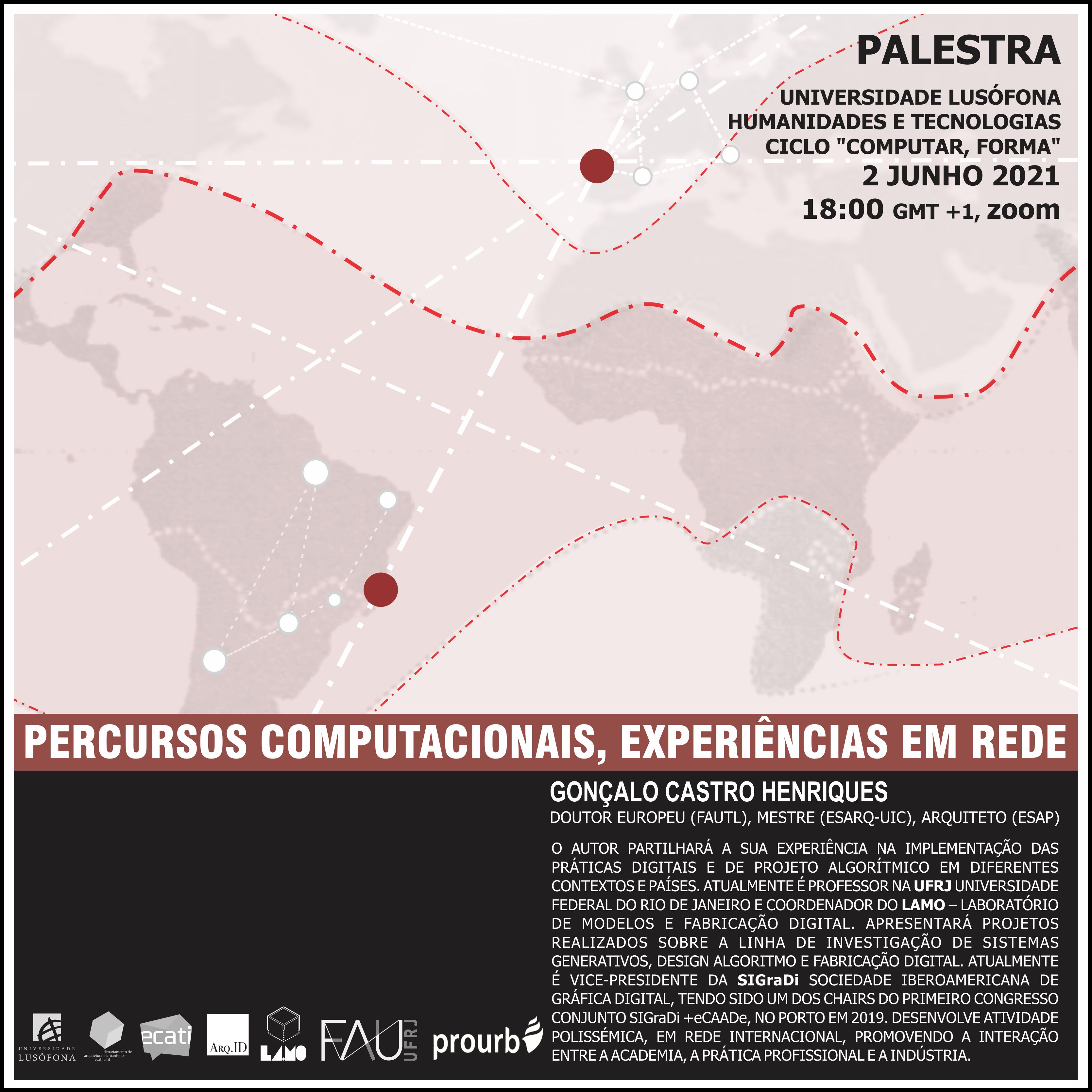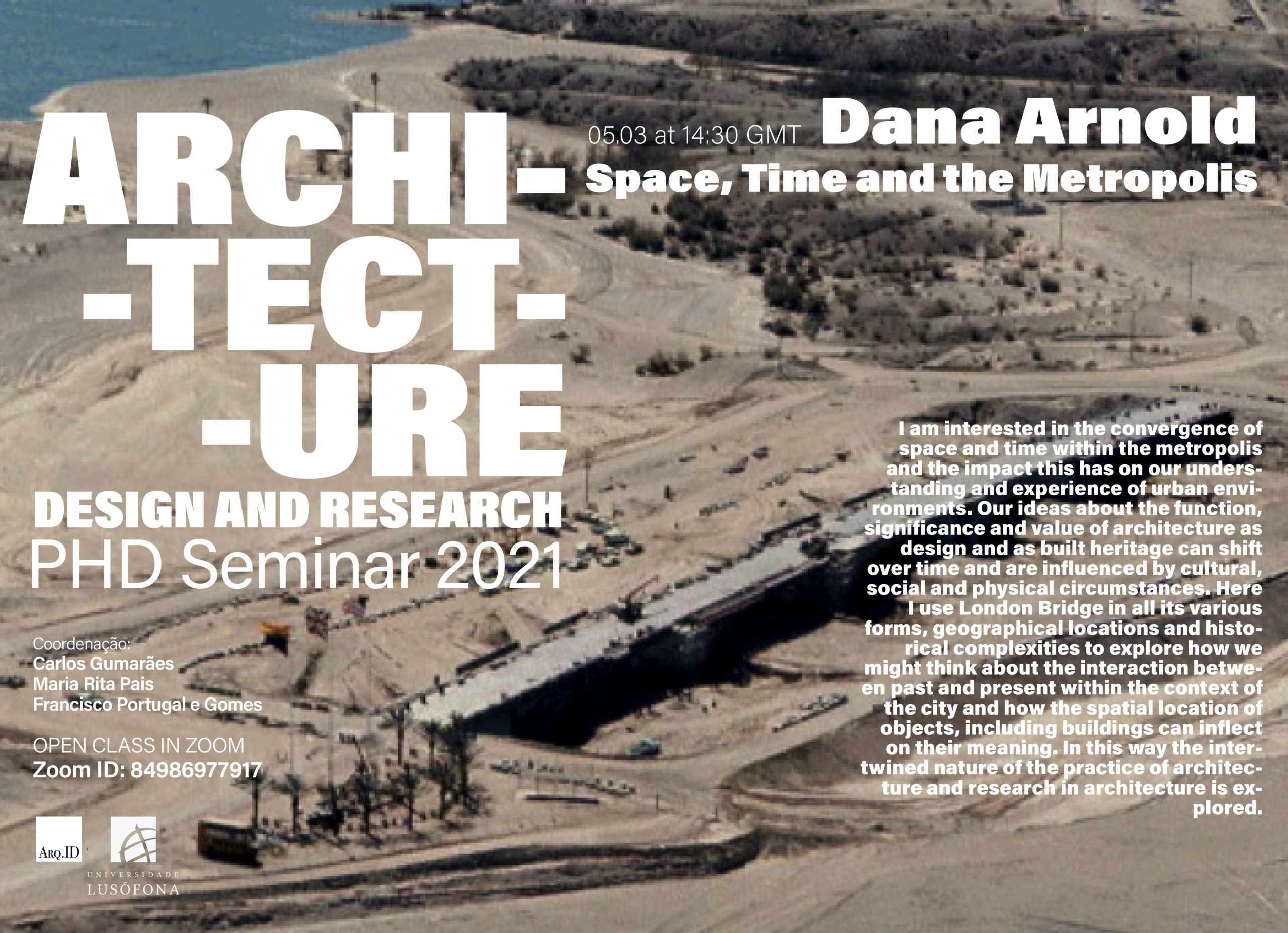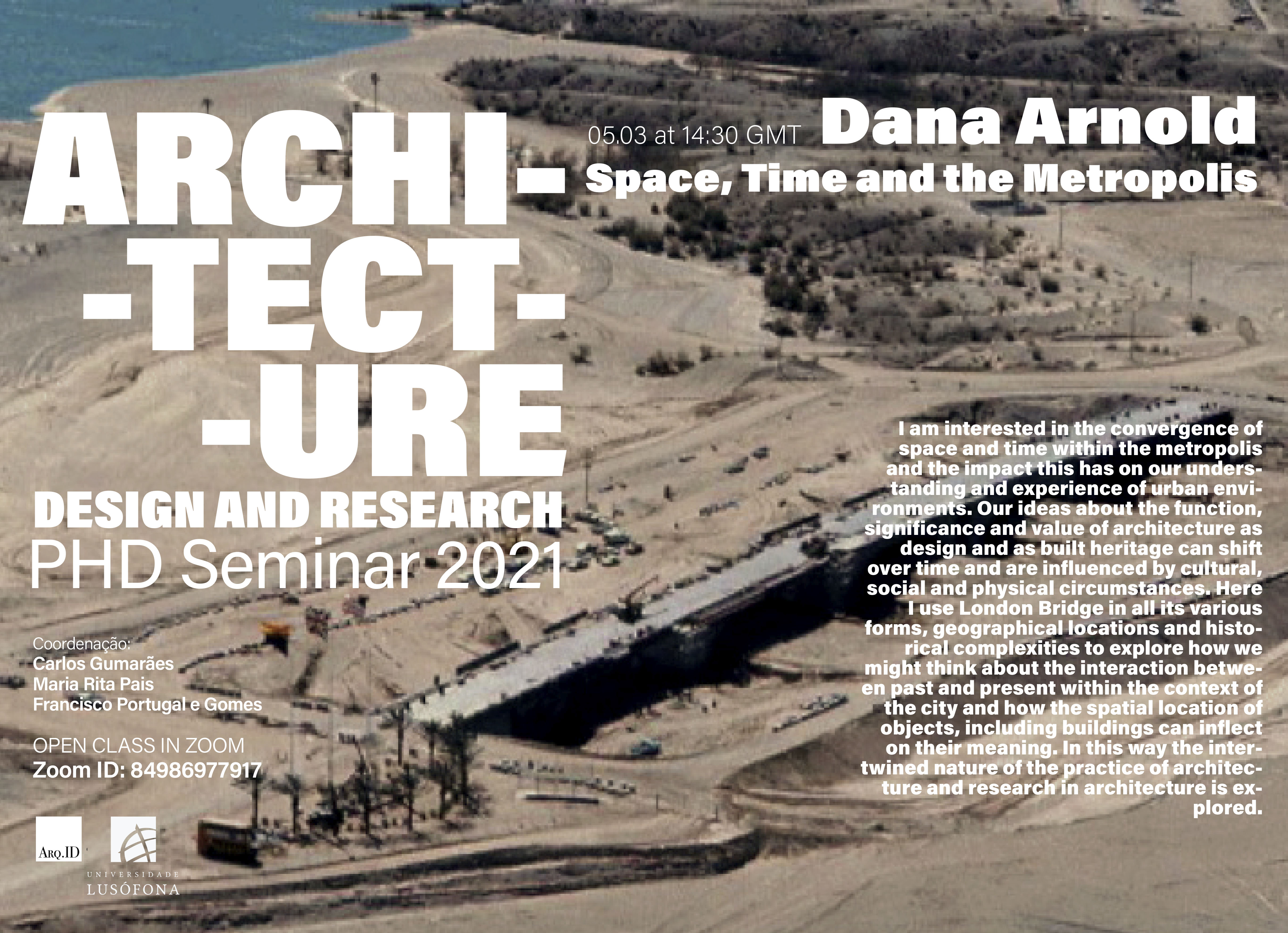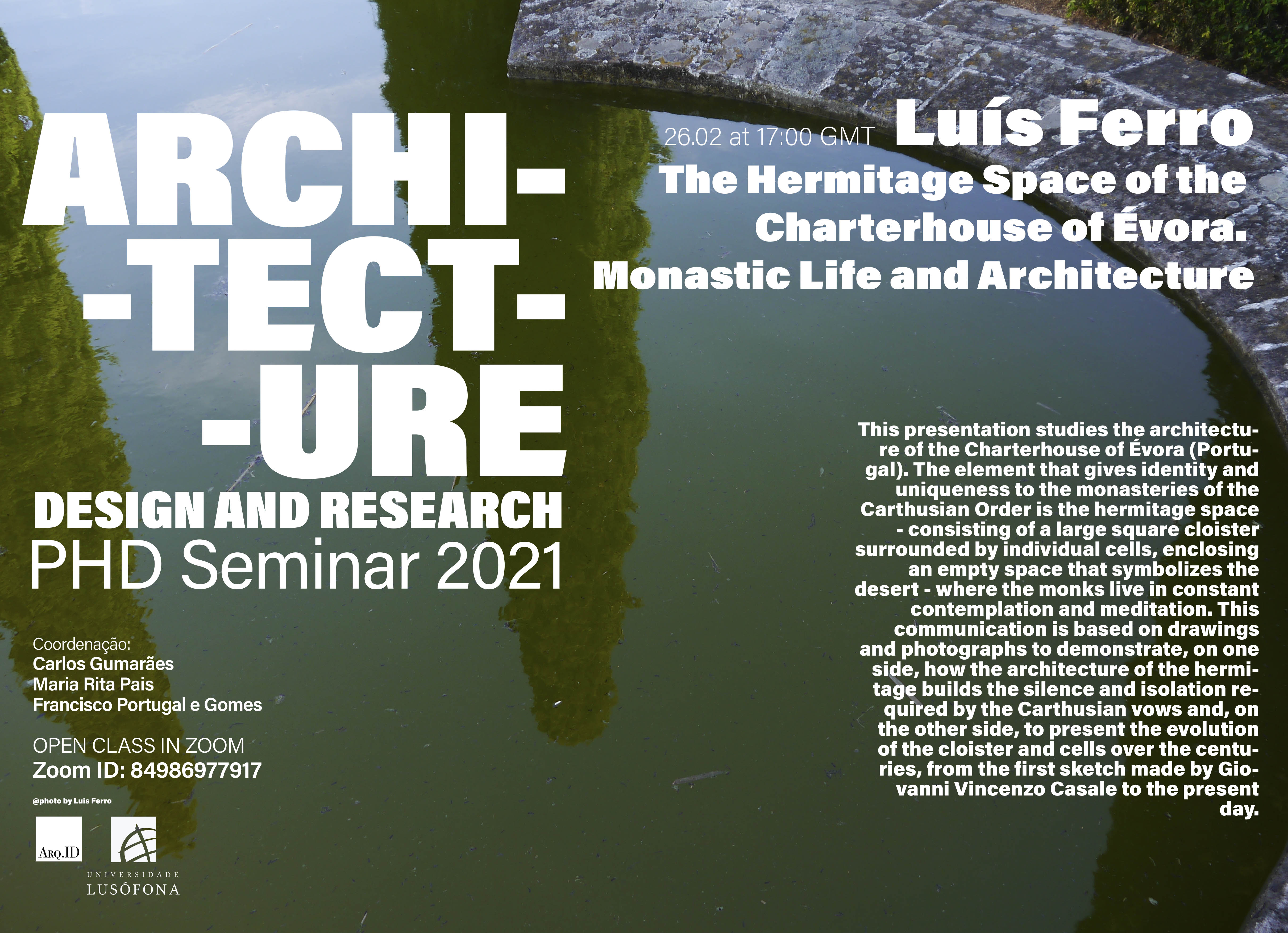
Conference cycle COMPUTER, FORME – Gonçalo Castro Henriques

Date
06/02/2021
6 pm
Conference by Gonçalo Castro Henriques
https://videoconf-colibri.zoom.us/j/82681081089?pwd=dSt4SFJNT2FVZVR6ZCtwWkw0TnVzZz09


Date
06/02/2021
6 pm
Conference by Gonçalo Castro Henriques
https://videoconf-colibri.zoom.us/j/82681081089?pwd=dSt4SFJNT2FVZVR6ZCtwWkw0TnVzZz09


The Architecture Departments of Lusófona University of Lisbon and Oporto are organizing a seminar – Architecture: Design and Research – for the current academic year.
This week:
05 March 2021,
14:30 (GMT)
We invite you to participate: Zoom (class): https://videoconf-colibri.zoom.us/j/84986977917
I am interested in the convergence of space and time within the metropolis and the impact this has on our understanding and experience of urban environments. Our ideas about the function, significance and value of architecture as design and as built heritage can shift over time and are influenced by cultural, social and physical circumstances. Here I use London Bridge in all its various forms, geographical locations and historical complexities to explore how we might think about the interaction between past and present within the context of the city and how the spatial location of objects, including buildings can inflect on their meaning. In this way the intertwined nature of the practice of architecture and research in architecture is explored.
My work focuses on histories of architecture and urbanism in relation to social and cultural theory. A number of my books, articles and edited volumes have made a substantial contribution to our understanding of London as a global city and as a visual phenomenon. For instance, my trilogy of monographs The Spaces of the Hospital, (Routledge 2013), Rural Urbanism: London landscapes in the early nineteenth century (MUP 2006) and Re-presenting the Metropolis (Ashgate 2000 and pbk 2018) offer theoretically informed, archivally based readings of the city as that enjoy international acclaim. I have also considered London in comparative contexts with other cities, especially Paris, and Tianjin in China. More broadly my work on the architectural dialogues between Britain, Turkey and the Middle East has explored how the built environment in all its complexities is experienced and used in the formulation of national and cultural identities and how these operate in a transcultural context.
The transnational aspects of my collaborative projects have informed my forthcoming book Architecture and Ekphrasis: Space, Time and the Embodied Description of the Past. Here I focus on the interaction between visual images and written histories of architecture. Using a broad evidence base of graphic representations of architecture, and drawing on my experience of cross-cultural dialogues, I argue that these images are in fact a form of writing that have syntactical and linguistic qualities that tell alternative histories of seeing and experiencing space.


Date
May 26th
6pm
Zoom: Eduardo C C Poster-Model https://videoconf-colibri.zoom.us/j/89927860820?pwd=aXptQXd2a29GdUZqR3ZkZGsrVFFHZz09


The Architecture Departments of Lusófona University of Lisbon and Oporto are organizing a seminar – Architecture: Design and Research – for the current academic year.
This week:
Luis Ferro – The Hermitage Space of the Charterhouse of Évora. Monastic Life and Architecture
26 February 2021,
17:00 (GMT)
We invite you to participate: Zoom (class): https://videoconf-colibri.zoom.us/j/84986977917
This presentation studies the architecture of the Charterhouse of Évora (Portugal). The element that gives identity and uniqueness to the monasteries of the Carthusian Order is the hermitage space – consisting of a large square cloister surrounded by individual cells, enclosing an empty space that symbolizes the desert – where the monks live in constant contemplation and meditation. This communication is based on drawings and photographs to demonstrate, on one side, how the architecture of the hermitage builds the silence and isolation required by the Carthusian vows and, on the other side, to present the evolution of the cloister and cells over the centuries, from the first sketch made by Giovanni Vincenzo Casale to the present day.
Luís Ferro is an architect based in Évora, Portugal, where he practices his professional activities since 2012. He is a PhD student of FAUP, and has an M.A. from the University of Évora (2010), having been an Erasmus student in Yildiz Teknik Üniversitesi in Istanbul. Between 2013 and 2015, was as Assistant Professor in the Department of Architecture from the University of Évora, and, between 2015 and 2016, was the coordinator of the project entitled «Sacred Places: Cubas from the Kûra of Beja» (Calouste Gulbenkian Foundation, n.139754). Currently, he is a Researcher at CHAIA/UÉ and CEAUP/FAUP.
He has published several papers and has presented communications in Portugal, Spain, France, England, Finland and USA, having been awarded with the «Prémio Estágios em Portugal e no Mundo» (Portuguese Order of Architects) in 2014 and the «Prémio Arquitectos Agora 2016» (Portuguese Order of Architects). In 2019, he has published the book entitled «O Eremitério da Cartuxa de Évora: Arquitectura e Vida Monástica» (ISBN: 978-989-54274-1-3), that was awarded with the Prémio Frei Bernardo Domingues, O.P. 2019 (Cultural Institute D. António Ferreira Gomes).


The Architecture Departments of Lusófona University of Lisbon and Oporto are organizing a seminar – Architecture: Design and Research – for the current academic year.
This week:
19th of February
16:30 (GMT)
Nora Wendl comes in to share her class with us: Each Story is an Anti-Story.
You are welcome to watch on Zoom: https://videoconf-colibri.zoom.us/j/84986977917
Every History is an Anti-History
The exhibition Edith Farnsworth: Reconsidered re-presents the Mies van der Rohe-designed Farnsworth House (Plano, Illinois, US, 1951) around the life and desires of the client, Dr. Edith Farnsworth, a Chicago-area physician, ground-breaking nephrologist, and poet. This re-inhabitation of the house with period furniture (and reproductions)—the result of a collaboration with the National Trust, Farnsworth House Director Scott Mehaffey, and Chicago-based architect Rob Kleinschmidt—approximates how the house may have appeared during a very uncertain time in its history: 1951-1954, during which Mies and Farnsworth sued and countersued one another, respectively. At stake was Farnsworth’s very ownership of the house: if Farnsworth lost the case, she would forever be barred from the property.
This seminar will depart from this specific historical moment and its temporary exhibition to focus on the questions of authorship and ownership that have, since the house’s very completion and its earliest reviews in architectural media, divided the narrative of this structure. Problematizing American institutions’ reliance on private patrons, patrilineal lines of wealth, and the inherited narratives that accompany them, I reveal my own frameworks for engaging with institutional opacity as a material reality and subject itself by engaging it in the performative practices of filmmaking, poetry, autobiography, and photography.
This seminar will reveal twenty years of my own practice of working with institutional opacity and omission both within and beyond the site of the archive. For every researcher, an entirely different set of biopolitics conditions not only access to documents, but their ability to give voice to them, to participate in authoring new accounts of history. In this seminar, I argue that these biopolitical conditions must give rise to new modes of authoring and performing architectural history.
Nora Wendl is Associate Professor of Architecture at the University of New Mexico, where she also serves as Associate Chair for Graduate Studies. Her work, across scales and media, investigates the occlusions of architectural historiography through methods involving image, text, narrative, performance, and exhibition.
Her exhibition work—from films to installations—has been supported by grants and residencies made possible by the Graham Foundation for Advanced Studies in the Fine Arts, Santa Fe Art Institute, and the National Trust for Historic Preservation, among other institutions. Wendl’s exhibitions and interviews with her have also been featured in Southwest Contemporary, Gray, Preservation Magazine, Chicago Tribune, and Architectural Record. She has published in journals including Architecture and Culture, Forty-Five: A Journal of Outside Research, Journal of Architectural Education, Offramp, On Site: Review, Studies in the History of Gardens and Designed Landscapes, and Thresholds.
She is also co-editor and contributor to Contemporary Art about Architecture: A Strange Utility (Ashgate, 2013; Routledge, 2016), which positions artists as co-producers of architectural history and theory.
Wendl holds B.Arch. and M.Arch. degrees from Iowa State University, where she was also the Pearl Hogrefe Fellow in Creative Writing (2004-2005). She has taught architecture studio, theory, and writing courses at universities across the United States since 2008.